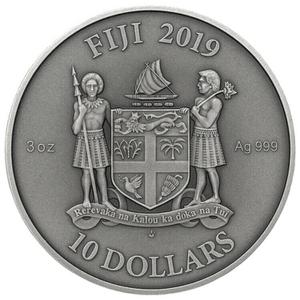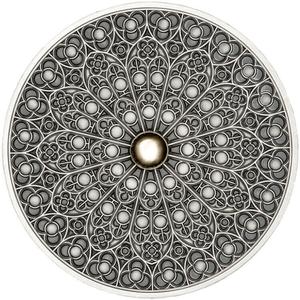Silver Three Ounces 2019 Notre Dame, Coin from Fiji - detailed information
Silver Three Ounces 2019 Notre Dame, Coin from Fiji
 |
| Royal Mint |
Showing 100 from a total of 147 coins of type: Unsorted
| Coin Name | Mintage | Effigy | Legend |
|---|---|---|---|
| Silver Ounce 1980 Anniversary of Independence | unknown | ||
| Silver Ounce 1993 William Bligh | unknown | ||
| Silver Ounce 1993 Abel Tasman | unknown | ||
| Five Dollars Silver 1994 London House | unknown | ||
| Ten Dollars Silver 1997 Wedding | unknown | ||
| Silver Ounce 1997 Diana Princess of Wales | unknown | ||
| Five Dollars 1999 Millennium | 10,000 | ||
| Silver Ounce 2002 Golden Jubilee | unknown | ||
| Ten Dollars 2003 Gold | unknown | ||
| Five Dollars 2006 Gold Stonehenge | 7,500 | ||
| Five Dollars 2006 Gold Ayers Rock | 7,500 | ||
| Five Dollars 2006 Gold Transylvania | 7,500 | ||
| Five Dollars 2006 Gold Atlantis | 7,500 | ||
| Five Dollars 2006 Gold Bermuda Triangle | 7,500 | ||
| Five Dollars 2006 Gold Nazca | 7,500 | ||
| Five Dollars 2006 Easter Island | 7,500 | ||
| Silver Ounce 2007 White Collared Kingfisher | unknown | ||
| Ten Dollars 2010 Gold Neptune | 2,000 | ||
| Ten Dollars 2010 Ancient Egypt Nefertiti | unknown | ||
| Ten Dollars 2010 Ancient Egypt Gods | unknown | ||
| Ten Dollars 2010 Ancient Egypt Anubis | unknown | ||
| Ten Dollars 2010 Ancient Egypt Horus | unknown | ||
| Ten Dollars 2010 Ancient Egypt Sennefer | unknown | ||
| Ten Dollars 2010 Ancient Egypt Scarab | unknown | ||
| Ten Dollars 2010 Ancient Egypt Eye of Horus | unknown | ||
| Ten Dollars 2010 Ancient Egypt Amenhotep | unknown | ||
| Ten Dollars 2010 Ancient Egypt Tutankhamun | unknown | ||
| Ten Dollars 2010 Ancient Egypt Scribe | unknown | ||
| Ten Dollars 2010 Gold Earth | 2,000 | ||
| One Dollar 2010 FIFA World Cup | unknown | ||
| Ten Dollars 2011 Gold Namibia | unknown | ||
| Ten Dollars 2011 Gold South Africa | 5,000 | ||
| Ten Dollars 2011 Gold Pamukkale | 5,000 | ||
| Ten Dollars 2011 Gold Monument Valley | 5,000 | ||
| Ten Dollars 2011 Gold Amazon | 5,000 | ||
| Ten Dollars 2011 Gold Halong Bay | 5,000 | ||
| Ten Dollars 2011 Gold Matterhorn | 5,000 | ||
| Silver Ounce 2011 Year of the Rabbit | unknown | ||
| Two Dollars 2012 | unknown | ||
| Ten Dollars 2012 Princess Olga | unknown | ||
| Silver Two Ounces 2012 Archangel Michael | unknown | ||
| One Dollar 2014 Year of the Horse, Filigree | unknown | ||
| Silver Ounce 2014 Year of the Horse - Ying Yang | unknown | ||
| Ten Dollars 2015 Ancient Sarcophagus | unknown | ||
| Silver Ounce 2015 Year of the Goat | unknown | ||
| One Dollar Silver 2015 Year of the Goat | unknown | ||
| Silver Ounce 2015 Year of the Goat - Ying Yang | unknown | ||
| Silver One Hundred Grams Bar 2015 Argor-Heraeus | unknown | ||
| Silver Half Kilo Bar 2015 Argor-Heraeus | unknown | ||
| Silver Five Kilos Bar 2015 Argor-Heraeus | unknown | ||
| Gold Quarter Ounce 2016 Lukas Krpalek | 200 | ||
| Silver Half Ounce 2016 Lukas Krpalek | 500 | ||
| Gold Quarter Ounce 2016 Arnošt Petráček | 200 | ||
| Silver Half Ounce 2016 Arnošt Petráček | 500 | ||
| Silver Three Ounces 2016 Unicorn | 999 | ||
| Silver Three Ounces 2016 Green Dragon | 999 | ||
| Silver Ounce 2016 Pearl Lunar Monkey | 8,888 | ||
| Silver Ounce 2016 Captain America vs Iron Man | 3,000 | ||
| Silver Ounce 2016 Black Widow | 3,000 | ||
| Silver Ounce 2016 Falcon | 3,000 | ||
| Silver Ounce 2016 Black Panther | 3,000 | ||
| Silver Ounce 2016 Winter Soldier | 3,000 | ||
| Silver Ounce 2017 Collared Lory | 2,000 | ||
| One Dollar 2017 Collared Lory | 7,500 | ||
| Silver Ounce 2017 Winter Olympics - Snow Sports | 2,000 | ||
| Silver Ounce 2017 Winter Olympics - Ice Sports | 2,000 | ||
| Silver Ounce 2017 Pearl Lunar Rooster | 8,888 | ||
| Gold Half Gram 2017 Athens - Parthenon | 7,500 | ||
| Gold Half Gram 2017 India - Taj Mahal | 7,500 | ||
| Gold Half Gram 2017 San Francisco - Golden Gate Bridge | 7,500 | ||
| Gold Half Gram 2018 Paris - Eiffel Tower | 7,500 | ||
| Half Dollar 2018 Space Exploration | unknown | ||
| Gold Ounce 2018 Coca-Cola Cap | 250 | ||
| One Dollar Silver 2018 Coca-Cola Cap | unknown | ||
| One Dollar 2018 Tree Frog | 7,500 | ||
| Silver Ounce 2018 Coca-Cola Cap | 5,000 | ||
| Twenty-five Dollars Gold 2018 Coca-Cola | 1,000 | ||
| Silver Three Ounces 2019 Notre Dame | unknown | ||
| Silver Ounce 2019 Coca-Cola - Polar Bear | 2,500 | ||
| Silver Ounce 2019 Coca-Cola Santa Claus | 25,000 | ||
| One Dollar Silver 2019 Hershey Kiss | 12,500 | ||
| Gold Half Gram 2019 Rome - Colosseum | 7,500 | ||
| Gold Half Gram 2019 Barcelona - Sagrada Familia | 7,500 | ||
| Gold Half Gram 2019 Great Wall of China | 7,500 | ||
| Gold Half Gram 2019 Berlin - Brandenburg Gate | 10,000 | ||
| Gold Half Gram 2019 New York - Statue of Liberty | 7,500 | ||
| One Dollar Silver 2020 Coca Cola Cap | unknown | ||
| One Dollar Silver 2020 Coca-Cola Cap - Sri Lanka | 1,000 | ||
| One Dollar Silver 2020 Coca-Cola Cap - Thailand | 1,000 | ||
| One Dollar Silver 2020 Coca-Cola Cap - Taiwan | 1,000 | ||
| One Dollar Silver 2020 Coca-Cola Cap - Egypt | 1,000 | ||
| One Dollar Silver 2020 Coca-Cola Cap - Japan | 1,000 | ||
| One Dollar Silver 2020 Coca-Cola Cap - Russia | 1,000 | ||
| One Dollar Silver 2020 Coca-Cola Cap - Korea | 1,000 | ||
| One Dollar Silver 2020 Coca-Cola Cap - Israel | 1,000 | ||
| One Dollar Silver 2020 Coca-Cola Cap - China | 1,000 | ||
| Silver Ounce 2021 Coca-Cola | 50,000 | ||
| Silver Ounce 2021 Mini-Hero - Captain America | 2,500 | ||
| Silver Ounce 2021 Mini-Hero - Iron Man | 2,500 | ||
| Silver Ounce 2021 Mini-Hero - Black Panther | 2,500 | ||
|
Showing 1 to 100 of 147 Coins. | |||
 |
| Buy American Gold Buffalo Coins |
My Collection
Silver Three Ounces 2019 Notre Dame: Details
Search Similar Coins to Buy (Affiliate Ad)
Share or Bookmark this Page


 Search for Fiji: Silver Three Ounces 2019 Notre Dame on eBay
Search for Fiji: Silver Three Ounces 2019 Notre Dame on eBay 

